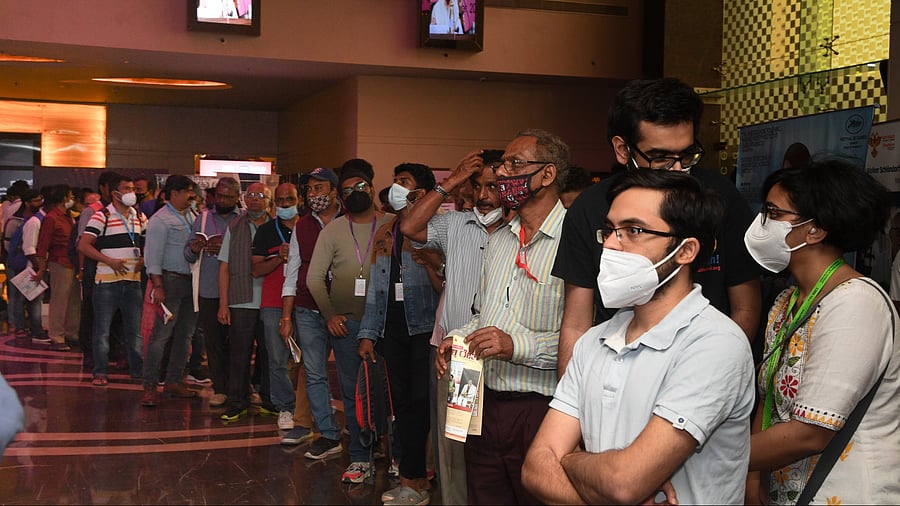
Delegates wait in a long queue for an international film at an earlier edition of BIFFes.
Credit: DH File Photo
In 2018, the Bengaluru International Film Festival (BIFFes) introduced the Kannada popular cinema genre in the competitive category. While the section isn’t a part of the competitive category anymore, the festival still provides a platform for these films.
The aim of an international film festival is to provide a platform for independent films and filmmakers and promote niche cinema. Whether mainstream cinema, made on the grounds of commercial viability, belongs here or not still remains a question.
Well-known film critic M K Raghavendra believes that screening local films made on commercial grounds will dampen the standards of an international film festival.
Sandhya Rani, author and film critic, makes an important point. “Why do films that are released in theatres and have a huge audience need a film festival? Independent films don’t get any other platform other than this, and these films go through a selection process before they’re selected for screening. What are such parameters for a commercial movie?” she questions.
Film critic and activist K Phaniraj questions the logic behind screening mainstream films at an international film festival that is intended at promoting alternative and experimental cinema. “What kind of support do films that have already reached the masses want from a festival?” he asks. “It just shows the hegemony of Kannada film producers who want to stake a claim in everything,” he adds.
Looking at mainstream and arthouse films on a general scale, film scholar, critic and author N Manu Chakravarthy says, “We cannot say arthouse cinema is always better than mainstream cinema. There are shoddy arthouse films as well.”
He believes that a well-crafted film catering to the masses, which has real content and without any artificial construction of silly songs and dance sequences, is a good film. “There is a belief that everything popular is bad. I want to dispel that notion and argue that there can be very good popular films,” he says.
Speaking about the Kannada popular films that have been screened in the recent few editions of the festival, he says, “A better choice should have been made, which I hope will be made this time.”
Anandhu Mohan from Kerala, who attends BIFFes every year, says he enjoys watching Kannada commercial films at the festival. “Where else can we watch a helpless Hossain Sabzian’s plight and tears on one screen right after Upendra’s character holding an AK47 with a badass smile,” he quips, adding, “They act as a good filler between serious films.”
Anju Asha Ananth, a cinephile and filmmaker, believes film festivals need to be inclusive and all films should be screened. “Popular films can be used as a tool to attract mass audiences to film festivals where they can also be exposed to niche cinema and world cinema. The chances are slim but it is a possibility,” she opines.
Vivekananda Kodandaraman, who has been attending and following BIFFes for at least 10 years, recalls how he saw an empty hall for a popular movie, when there were long queues for international films. He quotes Ken Loach and says: “‘Film making is a privilege and should not be thrown away’. Similarly, the access to films is also a privilege and this being wasted is very unfortunate.”